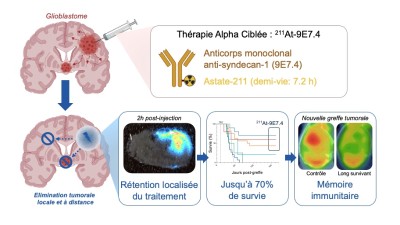Glioblastome: a promising lead against cancer
Researchers at the CRCI2NA (University of Nantes, University of Angers, Inserm, CNRS) have successfully treated glioblastoma, the most aggressive form of brain cancer, in mice. The treatment, which involved the administration of antibodies labelled with a radioelement, demonstrated long-term efficacy in protecting the animals from disease progression and potential relapse. Their findings have recently been published in the journal eBioMedicine, which is published by The Lancet.
 Annually, approximately 3,500 new cases of glioblastoma are diagnosed in France. Glioblastoma is the most commonly diagnosed form of brain cancer and is also highly aggressive. Despite treatment with surgery and/or drugs and radiotherapy, recurrence is a common occurrence. The median survival rate is less than two years after conventional treatments (a recent advance involves the use of a portable medical device that generates electric fields).
Annually, approximately 3,500 new cases of glioblastoma are diagnosed in France. Glioblastoma is the most commonly diagnosed form of brain cancer and is also highly aggressive. Despite treatment with surgery and/or drugs and radiotherapy, recurrence is a common occurrence. The median survival rate is less than two years after conventional treatments (a recent advance involves the use of a portable medical device that generates electric fields).
One of the research teams at the Centre de recherche en cancérologie et immunologie intégrée Nantes-Angers (CRCI2NA), known as 'Gliad', is engaged in the investigation of innovative alternatives for the locoregional treatment (in the brain) of glioblastoma. Based in Angers, the team is engaged in research on treatment resistance, with a particular focus on two approaches: the development of vectorised internal radiotherapy combined with in situ radiosensitisation, and the development of interventional implants capable of modifying the tumour ecosystem and/or interfering with the behaviour of tumour cells.
A collaborative project
One of their recent advances was the subject of an article published online in open access on 20 June 2024 in eBioMedicine, one of the journals of The Lancet Group, which presents promising discoveries before they are clinically tested in humans. These results are the fruit of a collaboration strengthened in 2019 between Gliad, led by Emmanuel Garcion, and another CRCI2NA team, Nuclear Oncology, led by Michel Chérel, as part of Labex Iron (Innovative Radiopharmaceuticals in Oncology and Neurology). The work was entrusted to Loris Roncali as part of his doctoral thesis, which was carried out between Nantes and Angers.
Emmanuel Garcion, director of neuro-oncology research at Inserm, said: "We treated the brains of mice with glioblastoma using a monoclonal antibody tagged with a radioactive isotope of astatine, astatine-211, the rarest natural element on the planet. The treatment targeted a glioblastoma surface molecule associated with tumour aggressiveness, syndecan 1".
Vectorised radiotherapy
François Hindré, Michel Chérel and Emmanuel Garcion are the project's promoters, and Loris Roncali is the study's lead author.
Each trial was a race against time. "We used the cyclotron at Arronax Nantes to produce astatine 211," explains the Angers researcher. "But this is an element that loses its radioactivity very quickly - half every 7 hours. So it had to be attached to the antibody quickly and then the radiotherapeutic molecule had to be transported to the experimental room for application. This required a great deal of coordination between the two teams, with up to fifteen people sometimes mobilised for the same experiment, which is rare".
Findings: "We achieved a 70% survival rate in the best group of mice, with eradication of the tumours," notes Emmanuel Garcion. "We also observed a reduction in secondary tumours and long-term immunological protection. When we try to re-implant the disease, the mouse doesn't develop it. They are protected. No relapse. This is a very promising result for human application, demonstrating the benefits of radiopharmaceuticals and vectored radiotherapy".
"Development of this strategy will continue in preparation for potential clinical trials. We need to humanise the antibody and study the toxicity of the treatment... There is still a long way to go, but the results offer real hope".
